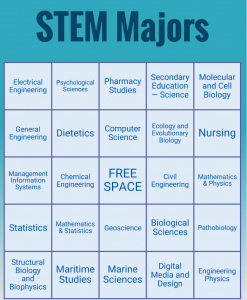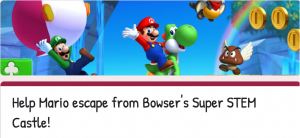Experiments
Fireworks in a Jar
Water and oil do not mix together, and food coloring can only dissolve in water. When we poured the oil & food coloring into the water, the oil stayed at the top because it is less dense than the water, plus the oil and water do not mix. The food coloring drops are heavier than the oil so they slowly fall into the water and start dissolving. This looks like a miniature explosion and it’s how we get our fireworks in a jar!
More resources: https://www.education.com/science-fair/article/pepper-and-soap-experiment/
The pepper and soap trick also works a similar way. This website also has other fun science projects to try.
Suggested age group: K-6th grade
Make Your Own Sidewalk Chalk!
This experiment is designed to demonstrate how to apply an understanding of chemical compounds. In this experiment, students will learn about calcium carbonate. Calcium carbonate (CaCO3) is a chemical compound made of calcium, carbon, and oxygen. It is a naturally occurring compound that can be found in many places in nature such as limestone, chalk, coral reefs, seashells, and marble. It can also be found in common household items like eggshells. Since eggshells and chalk both primarily consist of calcium carbonate, students can use the calcium carbonate in eggshells to make chalk.
You can find more science projects by following these links:
https://www.3plearning.com/blog/simple-chemistry-experiments-kids-home/
Suggested age group: K-6th grade
Created by: Somachukwu Ozuzu
Educational STEM
Eclipse!
This is a short educational video about Eclipses (Solar Eclipse, Lunar Eclipse, and Total Solar Eclipse) to help encourage students to notice how STEM is all around them!
NASA actually has a lot of classroom activities that would be great for further STEM exploration (ex. https://www.jpl.nasa.gov/edu/teach/activity/solar-system-bead-activity/). These activities can also be filtered based on interest, age/grade, etc. Here is the link to a few related to Eclipses: https://www.jpl.nasa.gov/edu/teach/tag/search/Eclipse
Suggested age group: K-3rd grade
Created by: Faith Thomas

What on Earth is Newton’s Third Law?
This is a brief introduction to Newton's Third Law of Motion. We briefly touch on topics like who Issac Newton was, what force is, what the Third Law means, and how this law applies in practical situations. The objective is to give students a bit of foundational physics knowledge, and generally demonstrate why people learn about physics.
To learn more about basic physics, a great online resource are the PhET Physics simulations (https://phet.colorado.edu/en/simulations/filter?subjects=motion&type=html&sort=alpha&view=grid). They're a bunch of free simulations that kids can play with, almost as a little game.
Suggested age group: 4-6th grade
The Flu Virus vs. HC19 Antibodies: The Fight is On!
This video is about antibodies called "HC19" that can surround influenza virus to prevent the virus from attaching to human cells. When this happens, the virus cannot get into the cell and cannot replicate. My research looks at how many antibodies it would take to prevent the flu from infiltrating humans to reproduce and make us sick!
COVID-19 has shown the world how important viral research and vaccine development are. I would highly suggest that you keep up to date on trusted news articles that discuss the science behind viruses and vaccines. If you are interested in how biology works at the cellular/molecular level, definitely check out some educational videos on YouTube to see how our bodies work at the minute level! There are tons of different viruses, but since Influenza is one of the most common, getting to know about the flu first is a great place to start!
Suggested age group: High School
Created by: Dhruv Dang

College Life
Biking Around UConn
Watch the tour of UCONN, and try to find all the locations from the tour using OpenStreetMap: https://www.openstreetmap.org/#map=17/41.80666/-72.25201 . After the presentation, either make a list of what you'd look for in your future college, and what parts of UCONN made you think of that. Look up a UCONN building that wasn't included on the tour and see what resources or rooms it has for STEM students.
For future exploration: They can explore https://www.engr.uconn.edu/ to find where their major of interest has facilities on campus or what facilities that major has access to.
Suggested age group: K - High School
Created by: Owen Spangler

UConn Campus Walking Tour
This is a walking tour of the UCONN Storrs Campus. It’s full of fun facts about the university and has scenic videos from the major parts of campus.
Additional resources can be found at the main University of Connecticut website.
Suggested age group: 4th grade - High School
Created by: Jessica Berry

Eat and Move as I Like! A fun and interactive way to learn about healthy eating!
My research project is centered on investigating the effectiveness of serious gaming on health promotion among teens and young adolescents. The game itself consists of a story mode which focuses on introducing players to the 5 major food groups and outlining foods to eat and avoid within each food group. As a player you are in control of a food basket and must maneuver your basket to collect the healthy foods from each food group while avoiding any unhealthy foods. The game offers a nice challenge as players must be able to distinguish between different foods from different food groups in addition to keeping track of all unhealthy substitutes as they progress.
Students could continue their STEM/Learning exploration based on my project by investigating/identifying health challenges that may stand to benefit from being presented in a game format. In-visioning how a game could help inform and motivate behavior change based on improving exercise habits could be an example of a topic for a future serious game.
Suggested Age group: 4th grade - Middle school
Created by: Lavar Johnson

Why I Chose my EEB Major
Understanding what we learn in the EEB major and how that knowledge can be used in different ways.
https://www.pbs.org/wgbh/nova/topic/evolution/ has good videos that give an overview of evolution
Suggested age group: Middle - High school
Created by: Mita Kale
The Vast Mechanical Engineering Major
To show young students that Mechanical engineering provides a wide skill set to be employed across different industries.
To motivate young students to become Mechanical Engineering Majors in hope of a better future
To send a message to young students that embracing one's true passion early can be very rewarding.
Suggested age group: Middle - High school
Created by: Gabriel Millan Garcia
Why I Chose Physiology & Neurbiology
Created by: Malavika Madan
Why I Chose Biomedical Engineering
Created by: Eric Zeiberg
Mental Health
Meditation Tips!
It can be very overwhelming having to be in front of your computer all day. I talk here about meditation, which is something I've learned to destress and recharge. I talk about how my lifestyle prompted me to look into this practice and how it can be helpful. I also briefly touch on the interesting history of meditation, and how it is used today.
I highly suggest looking up relaxing meditation sounds when getting started, cause it may be difficult to destress all on your own. There are a diverse set of mediation sounds and guided meditations on youtube to get you started.
Games
STEM Jeopardy Game

This is a fun and engaging game for elementary-aged students to learn a little bit more about the fields of STEM: science, technology, engineering, and math. Each category has simple questions to test student's knowledge and have them practice trivia questions to learn more about what these individual fields look like. This is a jeopardy-style game created on PowerPoint. All of the slides are hyperlinked for your convenience and you are welcome to edit the questions to better suit your students! Enjoy!
Suggested age group: K-3rd grade
Created by: Ashanthi Snell
STEM Major BINGO

STEM is more than biology and engineering. There are so many more fields to explore that involve the use of science, math, technology, and engineering- here are some examples of majors!
Suggested age group: 4th grade & up
Created by: Shaharia Ferdus
Help Mario escape from Bowser’s Super STEM Castle!

The objective of this escape room is for the students to utilize the broad STEM knowledge they currently have to escape from Bowser's Castle as soon as possible to save Princess Peach. Hopefully by mixing the themes of Super Mario and STEM, the kids can have some fun while they put their current STEM knowledge to work. The questions range from basic math problems, scientific terms, to current landmarks and important scientists.
Suggested age group: 4-6th grade
Created by: Fernando Diaz